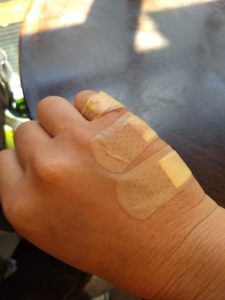The Land of the Rising Sun from Mt. Fuji
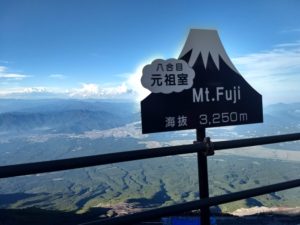
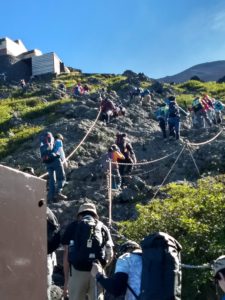 I read everything I could about Fuji but the weather was the determinant. I was staying in Tokyo for almost 3 weeks so I hoped there would be a good weather window. The weather was actually quite nice, so I planned to go on a Sunday to Monday, in hopes that there would be slightly less pilgrims than a Saturday. There were still thousands of people, but I was able to have a few moments to myself when traffic started to thin around the 7th station. Fujisan is broken into 10 stations, and most people start at the last bus stop at the 5th station.
I read everything I could about Fuji but the weather was the determinant. I was staying in Tokyo for almost 3 weeks so I hoped there would be a good weather window. The weather was actually quite nice, so I planned to go on a Sunday to Monday, in hopes that there would be slightly less pilgrims than a Saturday. There were still thousands of people, but I was able to have a few moments to myself when traffic started to thin around the 7th station. Fujisan is broken into 10 stations, and most people start at the last bus stop at the 5th station.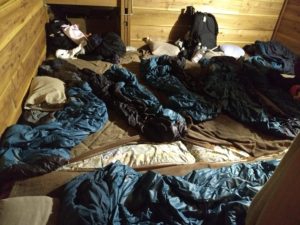
Like giant bunk beds, you had to duck as there was a layer of hikers sleeping above you. Many heads were bumped.
It only took me four hours to get to the hut via the popular Yoshida trail. I thought it would be 5-6 so I was surprised when I came up a switch back and there I was at Tomoekan, my hut at the 8th station. Since it was only 5pm I had some time to relax. I watched an amazing sunset and tried to sleep. At 10pm I still wasn’t asleep so I walked outside and watched a spectacular lightening storm in the clouds straight ahead. When I got back to Tokyo, I heard they had a wild thunderstorm. I think I finally slept a couple hours before my alarm went off at 2am. A lot of people were already geared up, but I lolly gagged because the trail sign said it was only 80 minutes to the top, and sunrise was at 5:15am.
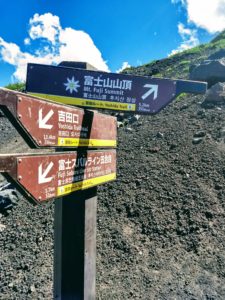
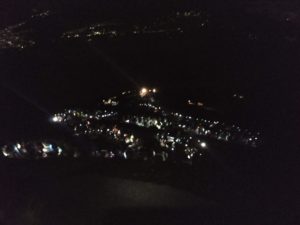
The string of lights are hikers’ headlamps.
At 4:45am, I finally crossed the last torii gate that signaled the summit. That last 80 minutes actually took over two hours! The sky was just firing up and the excitement was palpable. I found a spot to sit and take pictures, and give thanks.
After a while I walked the trail along the summit which took me to the highest point on Fuji and I saw the full moon setting. It was exactly what I wanted it to be.
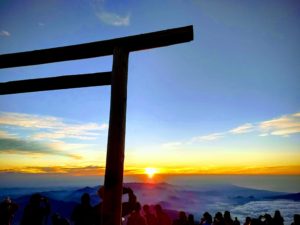
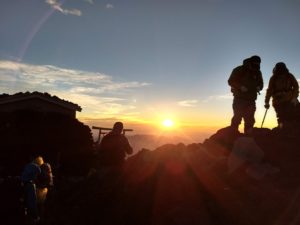
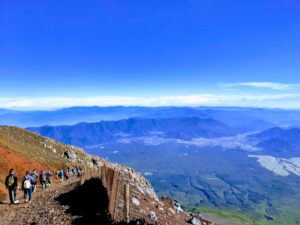
Finally close to the 6th station it started to flatten out a bit. I walked into the helmet rental hut and showed them my arm and said “Band-aid?”. They put some antiseptic on me (which is what I really wanted since I was covered in dust) and bandaged me up. I was happy again.
As I’m getting on the bus, it’s a 2.5hr trip back to Tokyo, a guy walks by wearing a Jack’s Generic shirt, a local Austin triathlon. And of course he’s from Austin but living in Tokyo now! Most of the people I’d seen in Fuji were Asians, but I wasn’t so surprised to see an Austinite, it’s a small world after all.
Tips:
- Take lots of cash for water, food snacks, postcards, and souvenirs.
- The bathrooms costs 200Y each, so bring coins as there’s no change available.
- Buy postcards and international stamps at the 5th station, and mail them at the post office at that station. You can also buy post cards at the mountain huts.
- There’s a website to help English speakers book mountain huts on the 7th station for an extra 1000Y. I missed the three day cutoff for that website, but was able to easily book myself for the 8th station and didn’t have to pay in advance.
- Take Band-Aids, or tape up your feet. They’ll take a pounding on the way down, or you may fall on jagged lava rocks.
